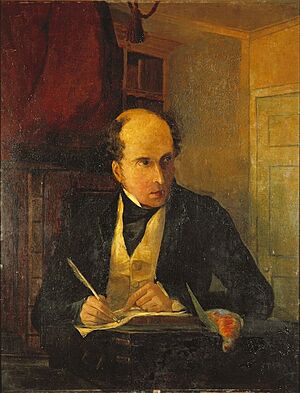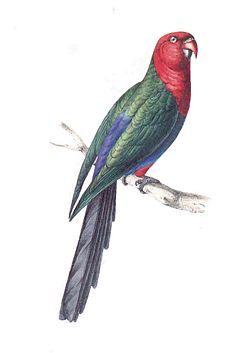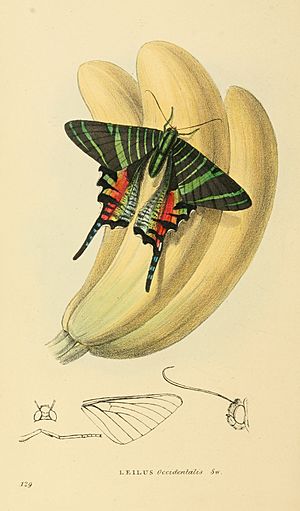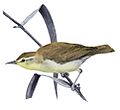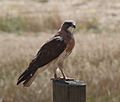William Swainson facts for kids
William Swainson (8 October 1789 – 6 December 1855) was an English naturalist and artist. He was very good at drawing and describing birds and other animals. He is famous for his detailed pictures and books about nature.
Quick facts for kids
William Swainson
|
|
|---|---|
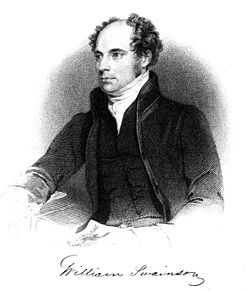 |
|
| Born | 8 October 1789 St Mary, Newington, London, England
|
| Died | 6 December 1855 (aged 66) Fern Grove, Hutt Valley, New Zealand
|
| Nationality | English |
| Citizenship | United Kingdom |
| Known for | Prolific illustrative works of natural history. Noted Quinarian. |
| Scientific career | |
| Fields | Ornithology, malacology, conchology, entomology, natural history |
| Notable students | Sir Walter Buller |
| Author abbrev. (botany) | Swainson |
| Notes | |
|
Emigrated to New Zealand in 1841
|
|
Contents
Early Life and Love for Nature
William Swainson was born in London, England, on October 8, 1789. His father and grandfather both worked for the government in customs.
When he was 14, William started working as a clerk in the customs office in Liverpool. He also became a member of the Linnean Society. This was a group for people who studied nature.
In 1815, Swainson became unwell after a trip to Italy. He decided to leave his job and focus completely on studying natural history.
Adventures and Discoveries
In 1816, Swainson traveled to Brazil with an explorer named Henry Koster. He spent two years exploring and collecting. When he returned to England in 1818, he brought back an amazing collection.
His collection included over 20,000 insects. He also had 1,200 different kinds of plants. He drew 120 types of fish and collected about 760 bird skins.
After this trip, Swainson started publishing many books. These books were filled with his beautiful illustrations.
Important Books and Art
One of his most important books was Fauna Boreali-Americana (1831). He wrote this with John Richardson. It was one of the first illustrated animal studies partly paid for by the British government.
He also created a second series of Zoological Illustrations (1832–33). He contributed to William Jardine's Naturalist's Library. He also wrote and illustrated eleven volumes for Lardner's Cabinet Cyclopedia. He was a very busy and talented author and artist.
Life in New Zealand
In 1839, William Swainson bought land in Wellington, New Zealand. He decided to move there in 1841. The journey was difficult, and his boat was damaged.
He bought a large piece of land in the Hutt Valley. He named his estate "Hawkshead." However, a Māori chief named Taringakuri claimed the land. This caused many years of problems for Swainson. He even joined a local army group against the Māori in 1846.
From 1841 to 1855, Swainson managed his land and continued some natural history work. In 1852, he took a job in Victoria, Australia. He was asked to study local trees by the leader, Charles La Trobe.
He finished his report in 1853. In it, he described many types of Eucalyptus trees. He found so many kinds of Casuarina trees that he ran out of names for them!
In 1854, Swainson returned to New Zealand. He lived at Fern Grove, Lower Hutt, where he passed away on December 6, 1855.
Family Life
William Swainson married his first wife, Mary Parkes, in 1823. They had four sons and one daughter. Sadly, Mary died in 1835.
He married again in 1840 to Ann Grasby. They had two daughters.
Interesting Facts About William Swainson
- Swainson was a very skilled artist. He drew many of the animals he studied himself for his books.
- He was one of the first naturalists to use a printing method called lithography. This was a cheaper way to print pictures and didn't need an engraver.
- He was elected a member of the Royal Society in 1820. This is a very important group for scientists.
- Many birds are still named after Swainson today. Famous naturalists named them in his honor.
- The plant group Swainsona is named after his cousin, Isaac Swainson.
- William Swainson was the first member of the Royal Society to move to New Zealand. He later became an honorary member of the Royal Society of Tasmania.
Animals Named After William Swainson
Many animal species are named after William Swainson. Here are some examples:
- Swainson's warbler (named by John James Audubon)
- Swainson's hawk (named by Charles Lucien Bonaparte)
- Swainson's thrush (named by Thomas Nuttall)
- Swainson's francolin
- Swainson's sparrow
- Swainson's antcatcher
- Swainson's fire-eye
- Swainson's flycatcher
- Swainson's toucan
Images for kids
See also
 In Spanish: William Swainson para niños
In Spanish: William Swainson para niños


